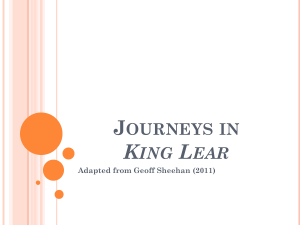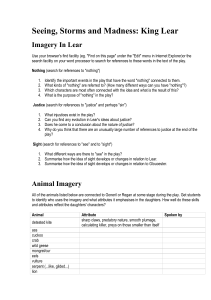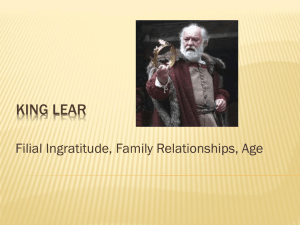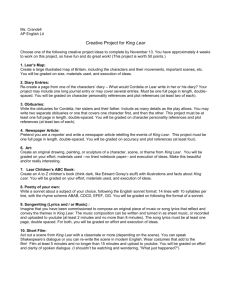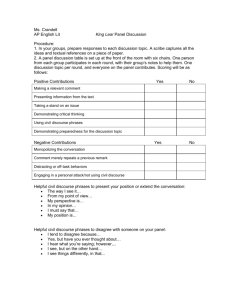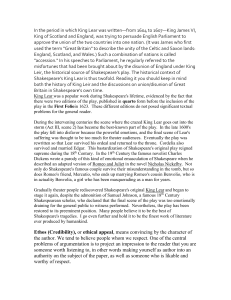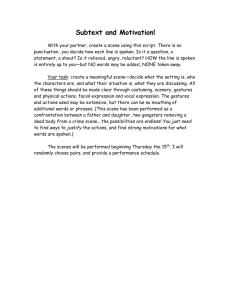Unit F663 - Section A - King Lear - Scheme of work
advertisement
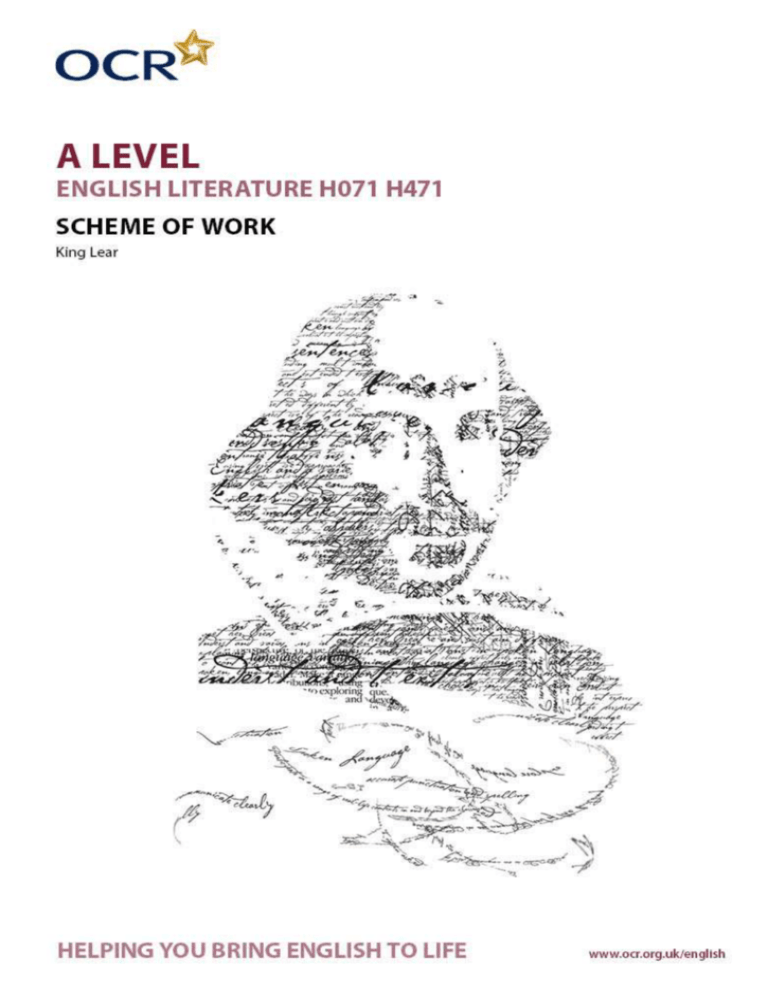
© OCR Page 1 of 21 V1.1 GCE English Literature HO71 H041 King Lear Introduction OCR involves teachers in the development of new support materials to capture current teaching practices tailored to our new specifications. These support materials are designed to inspire teachers and facilitate different ideas and teaching practices. Each Scheme of Work and set of sample Lesson Plans is provided in Word format – so that you can use it as a foundation to build upon and amend the content to suit your teaching style and students’ needs. The Scheme of Work and sample Lesson plans provide examples of how to teach this unit and the teaching hours are suggestions only. Some or all of it may be applicable to your teaching. The Specification is the document on which assessment is based and specifies what content and skills need to be covered in delivering the course. At all times, therefore, this Support Material booklet should be read in conjunction with the Specification. If clarification on a particular point is sought then that clarification should be found in the Specification itself . . © OCR Page 2 of 21 V1.1 GCE English Literature HO71 H041 King Lear Sample Scheme of Work GCE English Literature H071 H471 King Lear This Scheme of Work is designed to accompany the OCR GCE English Literature specification for first teaching from September 2008 Suggested Teaching Time: 80 Hours plus There are four phases: 1. Encountering the play, 2. Setting the agenda (AOs): 3. Working through the text: 4. Focusing and presenting outcomes All suggestions are merely that: guided exploration and the formation of the group’s own agendas are much more valuable than our suggestions - especially when the taught group feels that it is in control of its own agenda for learning. You will find life simpler if your school allows access to YouTube for the exploration of alternative performances. © OCR Page 3 of 21 GCE English Literature HO71 H041 V1.1 King Lear TOPIC OUTLINE SUGGESTED TEACHING AND HOMEWORK ACTIVITIES SUGGESTED RESOURCES POINTS TO NOTE Really good video version of play: choices include McKellen’s RSC Lear, Paul Scofield’s Lear and Olivier’s Lear. The McKellen is possibly the most accessible. It is available to stream, free at http://www.pbs.org/wnet/gperf/episodes/kinglear/background-on-king-lear/sources-forking-lear/summary/636/ Shakespeare will not have been encountered directly since GCSE: if they did a drama text as coursework at as this may be helpful in discussing means and methods of drama as genre. Phase 1 – Encountering the play Return to Shakespeare: recap of plays already known, and group discussion of essential background: preparation to ‘come back’ to Shakespeare building on literary perceptions gained over year 12. Prepare group to encounter a play open-mindedly: to watch and note their reactions as audience. It would be desirable for the first encounter section to have a strong sense of active workshop, and collective discovery, rather than being didactic. This makes this a very suitable activity for the end of the as year. Encountering Lear: The shape and effect of one version of the play How a play ‘happens’ to the individual audience member. Main discussion focus: why would one chose to be a playwright, instead of a novelist or a poet? What’s special, or distinctive, about theatre? Discussion and preparation for leading discussion at this point is really well supported by Sean McEvoy’s Shakespeare: the Basics and by Simon Palfrey’s Doing Shakespeare. Well thumbed copies should be available in the room! Encourage honest and direct note taking listing events, noting reactions moment by moment, and trying to trace ‘movements’ - the way in which the play falls into dramatic (as opposed to act and scene) divisions. Where do the significant breaks and changes happen? As the group watch the play, they should chronicle their reactions: bits they like and find awkward: can they begin to see how much of their reaction is the result of Shakespeare’s text, and how much the result of the way this production reads/ Dresses/stages things? Outcome: initial diagrammatic representation of the play’s episodes, presented as a big, communally designed, poster. They need to find a way of recording their reactions at this stage: they will be important in stage 4, when they pull their work together. Outcome: working notebook of reactions. (Discussion point: how does watching a play in class lose and gain over live performance?) © OCR Page 4 of 21 Can a continuous slot of time be gained in any way so the play may be watched without interruption in one movement? (may be a good activity for gained lesson time at end of year 12). It is so easy to lose the freshness of direct response to ‘first time’ encounter with a text, which will in time be overlaid by the experience of working, scene by scene, through the text. Most people who have seen this play throughout its life have probably only seen it once: to work, it has to work immediately. They need to ask ‘what is the play’s effect on me?' As the study progresses, other charts can be made - in particular, a chart showing language change in key characters over the play. GCE English Literature HO71 H041 V1.1 King Lear TOPIC OUTLINE Concluding the first phase: ‘beyond liking or understanding’ At this point, take a ‘plenary’ pause to pull together reactions to the matters described above. Whether or not they feel they like, or understand the play at this point, they need to look as objectively as they can at their shared reactions. They need to look at what their shared outcomes might be. SUGGESTED TEACHING AND HOMEWORK ACTIVITIES Outcome: brief chaired seminars: (preferably student-led): 1. First reactions to the play - a pooling of the notes written - big flipchart sheets of thoughts on paper 2. The shape of the play. Can we achieve a diagram of significant phases? Do they have anything to do with acts and scenes? 3. Resulting in agreed written summaries of ideas, displayed in the room. SUGGESTED RESOURCES POINTS TO NOTE Here we concentrate on the development of a sense of research project, research presentation, research display, and joint discovery. Management of the teaching space and the ‘proxemics’ of group interaction is important here: the room layout needs to change all the time, from auditorium to seminar space. Wall materials should be used to provide continuity: one lessons’ conclusions can provide a starting point next time. At A2 students need to begin to take responsibility for leading discussion and investigation. The teacher’s job is to subtly lead, and feed this enquiry, and to fuel it by tactically prompting students to lead seminar work: by pairing the leaders with less confident partners in group work, and by encouraging them to value the physical record of gained perceptions. Phase 2 - Setting the Agenda Introducing the raw materials of enquiry: Introducing the idea of Assessment Objectives (AOs) by subjecting one part of the play - the first act - to close scrutiny Use key questions below at each ‘stage in the play’s development, using AOs as ‘framework’ for interrogating the text. Experimenting with Assessment Objectives by close reading of the first ‘movement’ (Act 1) The AOs are not hurdles: they are a framework for analysis, and they equip the enquiring student with a way to organise ideas. They will be explored because they offer a toolkit for study. Use this framework with the group for each episode. For AO2, Some useful frameworks and discussions will be found in Simon Palfrey’s Doing Shakespeare This section of the course works on the assumption that the play - Phase 3 - will be studied as ‘running scenes’ which form identifiable dramatic units. These may be identified the group - those listed in Phase 3 below are merely an example of a way of dividing the play. © OCR Page 5 of 21 GCE English Literature HO71 H041 V1.1 King Lear TOPIC OUTLINE Examples of responses to Act 1 Episode 1 (or ‘running scene’) Act 1, scene 1 SUGGESTED TEACHING AND HOMEWORK ACTIVITIES AO2 looking at dramatic, narrative, poetic means Shaping of the action Language of dialogue Verse? Prose? Language register, from formal to intimate AO3 Views of the action within the text (characters on each other) critics productions AO4 Looking at context Issues of the time (including language - overlaps with AO2) Reflections of the age - then Reflections of the age - now How the play works for modern audiences Comparative In the opening exchanges between Kent and Gloucester what impression are we given of King Lear’s court? (e.g. Gossip - [AO2 register] about who is in favour / the impending division of land). Which other plays begin in media res? What is the effect of making us pick up the threads of an overheard conversation? SUGGESTED RESOURCES POINTS TO NOTE As it happens, the RSC edition of the play usefully identifies and establishes 20 ‘running scenes’ - continuous sequences of action, which seem as good a way as any to break the play down for study. Other textual instances for plays beginning in media res - Antony and Cleopatra, Hamlet - a chance to look at exposition. Fairy story instances for myth/romance discussion Clips on Casket Scene in Merchant Recording of Shapiro on Shakespeare and James 1 The agenda for study and enquiry should ideally be negotiated with the group, and responsibility for leading activities delegated to pairs, groups or individuals as far as possible. We only suggest some angles you may wish to explore. If you - or your group - can find better ways of exploring the scenes, use them! Practical First Impressions of Edmund – how would you direct this short scene? Edmund says little while his dad discusses the ‘good sport’ he had in conceiving him. What would his body language show? Textual Annotate Lear’s first speech: © OCR Page 6 of 21 GCE English Literature HO71 H041 V1.1 King Lear TOPIC OUTLINE SUGGESTED TEACHING AND HOMEWORK ACTIVITIES SUGGESTED RESOURCES POINTS TO NOTE consider symbolism of the map / connotations of ‘Our darker purpose’ / role of dowries in a patriarchal society / use of blank verse and the language of ceremony. Look at tone (AO2). Look at varieties of ceremonial staging of this scene. AO2: Focus on the different language styles used by Lear’s three daughters: Goneril and Regan’s use of hyperbole and analogy. Cordelia’s plainness. ‘Nothing’ will be a very important word in the play. What gives it its power in this first scene? AO 2/3/4: Discuss echoes of fairy tales and myths in the plot set-up and rule of three: e.g. Cinderella, Rumpelstiltskin, A Christmas Carol. Also (AO3) Shakespeare’s use of it e.g. in the’ casket test’ in Merchant of Venice. Is it credible to modern audiences that Lear would make such a terrible decision? AO2 Gather quotes from the first scene that shows Lear’s temper and violent imagination. Relate to the fact he is an absolute monarch used to being indulged. Practical Prepare hot seating – Jerry Springer-style role play for Lear, his daughters, their husbands/suitors and Kent. Title could be My Daughter Doesn’t Love me – So I’m Kicking Her © OCR Page 7 of 21 GCE English Literature HO71 H041 V1.1 King Lear TOPIC OUTLINE Act 1, Scene 2 Episode or ‘running scene 2’ SUGGESTED TEACHING AND HOMEWORK ACTIVITIES Out! All the central characters need to give their view on the events of the dramatic first scene! Another possibility is to write monologues exploring each sister’s inner thoughts in relation to the love test. Then test your accuracy by looking at their conversation at the scene’s end. Consider France’s speech ‘Fairest Cordelia’ and his use of paradox, that art most rich being poor’AO4 Look at Shapiro’s recent comments in his television series Shakespeare and James I on the topicality of issues of kingship and inheritance. Research definition of ‘Malcontent’ – how far does Edmund’s character seem to meet this definition? What motivates his cruelty? Compare with a soliloquy from Iago in Othello, or Richard’s address to audience in Richard III? How do we feel about him as we watch him? SUGGESTED RESOURCES POINTS TO NOTE Speech/audio/video material for Iago and Richard III (YouTube is easiest if permitted!) A Plaint to Man Hardy Wallchart materials for timeline showing ‘running scenes’ Characterisation: How is Edmund delineated from his father and brother? (e.g. his contempt for pagan beliefs like astrology, his brother and father’s gullibility in falling for Edmund’s rather clunky set-up) Scepticism ‘an admirable evasion of whoremaster man’ - Hardy’s poem A Plaint to Man can be a useful text to look at here. Like Edmund, Hardy believes we invent deities to avoid admitting responsibility for our own actions as human beings. © OCR Page 8 of 21 GCE English Literature HO71 H041 V1.1 King Lear TOPIC OUTLINE Act 1, Scenes 3 - 5 ‘Running scene 3’ SUGGESTED TEACHING AND HOMEWORK ACTIVITIES As the play progresses students should maintain plot timelines for both the main plot (Lear and his daughters) and the subplot (Gloucester and his sons) identifying similarities and differences between them. Could this be done collectively and posted on the walls? (AO2) How does the subplot add to the richness of the play? Does it ever distract from the main plot? At what points do they come together? 1.3 is a very short scene – discuss whether or not it should be cut from a production. What does it add/amplify/achieve? (AO2) (AO2) Read 1.4. Kent is the first character in the play to use a disguise. ‘Disguises are used in the play only by honest characters (Kent and Edgar)’. Is this entirely true? Compare speeches these characters make inside and outside disguise – what impact does disguise have on their language? How might disguise reflect the themes of the play? Look, on YouTube at several film versions of 1.4 focusing on how Lear and his retinue are represented. Often modern productions present them as rowdy – giving weight to Goneril’s complaints about their behaviour. What difference does this make to the meaning of the play? How would you direct this scene? (AO1/2/3) Can you find any contemporary material about court behaviour? (AO4) © OCR Page 9 of 21 SUGGESTED RESOURCES POINTS TO NOTE Clips (probably via YouTube) of Lear and his retinue in at least 2 other versions. References to, for example, Private Eye or Daily Mash (Internet) for discussion of satire and its uses. Research materials for ‘Fool” internet: Welsford The Fool also Uni of Chicago site about Court Jesters http://www.press.uchicago.edu/Misc/Chicago/ 640914.html Beginning of list of essential props for play: to enable discussion of staging. GCE English Literature HO71 H041 V1.1 King Lear TOPIC OUTLINE SUGGESTED TEACHING AND HOMEWORK ACTIVITIES SUGGESTED RESOURCES POINTS TO NOTE Research the role of the ‘court jester’. (AO4) The ‘all-licensed’ fool has the freedom to criticise Lear to his face in a way we may find surprising. Compare to role of modern satire shows such as Have I Got News For You. Why do people find the idea of the powerful being ridiculed so funny? Give out some of the Fool’s jokes / riddles from across the play. What wider points are they making about society? Why does Lear call him ‘a bitter fool’? As they never appear on stage together the Fool and Cordelia are sometimes played by the same actor. Why artistic reasons might there be to justify this doubling? The coxcomb is an important prop – what might it represent? Focus on Lear’s ‘Hear, Nature. Hear…’ speech. Look at the Imagery of violence and misogyny. (AO2) Phase 3 - Working through the play The remaining scenes of the play are more sketchily annotated: some are left blank. These are for the group to fill! Establishing an agenda for study is part of the study group’s collective role: but they must not lose sight of the AOs as a framework for interrogating the text. Familiarise students with question format by using OCR resource How to set an F663 Question, available from ‘Support Materials” on the website. Candidates should become practised at writing their own questions. We have highlighted some key lines in the comments to show how easily they have a bearing on - or might become - potential essay questions. Act 2, Scene 1 Running scene 4 Act 2. Scene 2 & 3 © OCR Page 10 of 21 Oswald and Kent – Shakespearean There is some excellent Shakespearean GCE English Literature HO71 H041 These scenes are not divided in V1.1 King Lear TOPIC OUTLINE Running Scene 5 SUGGESTED TEACHING AND HOMEWORK ACTIVITIES insults. (AO4) Kent derides Oswald with some of the most inventive insults in all of literature. As a class try making up some insults of your own in Kent’s style! On a serious note – does Oswald deserve the often harsh treatment he receives in the play? Research what the stocks were. (AO4) Does Kent deserve the stocks? What does his being placed in them represent? Look at the reasons Goneril and Regan give for Lear cutting his retinue? How do they look to modern audiences? Note the symbolism of a King’s retinue at the time Trace evidence (AO2) in speech register and tone in this scene of Lear’s fading confidence in his own power. Do you feel pity for him? Look for evidence of sarcasm, hesitation, incredulity, ranting, pleading Some critics sees Lear’s curse at Regan ‘Strike her young bones…with lameness’ as a hint Regan may be pregnant. How might this change our perception of this scene? (AO3) How do directors affect our response? (YouTube/Comparative videos) ‘O, reason not the need!’ Is one of the most famous speeches in Shakespeare’s canon. (AO2) Experiment with different ways of reading it aloud – ranting, hysterical, quietly and emotionally, confused. Which do you feels best suits the tone? © OCR Page 11 of 21 SUGGESTED RESOURCES insult material on the internet. POINTS TO NOTE most performing editions, and run as a unit Stocks: Wikipedia UN Declaration of Human Rights www.un.org/en/documents/udhr/ ‘Staging Storms in Shakespeare’s Theatres’ in Tiffany Stern and Farah Karim-Cooper (eds.) The Effects of Performance in the Theatres of Shakespeare and His Contemporaries (Arden Shakespeare, forthcoming). Also mrmorgans13english.pbworks.com/f/Storms +in+Shakespeare.ppt GCE English Literature HO71 H041 V1.1 King Lear TOPIC OUTLINE SUGGESTED TEACHING AND HOMEWORK ACTIVITIES SUGGESTED RESOURCES POINTS TO NOTE Discuss what kinds of ‘needs’ make humans different from ‘beasts’. And as a planet do we always make sure those needs are met for all citizens? Could look at UN Declaration of Human Rights. As play progresses Lear seems to learn more about the needs of the kinds of people in society he feels he has neglected as a King. Gather examples of this ‘social criticism’ Act 3 Scene 1& 2 Running Scene 6 The stage direction Storm and Tempest is symbolic and highly theatrical. What might it represent? How is the sense of storm and tempest evoked by language? By dramatic devices?. Look at artistic representations of Lear upon the heath. Why does this image have such continuing power? How can this be staged? Google Images ‘Lear on the Heath’. (AO2) Explore - and draw - some of the images of apocalypse in Lear’s speeches ‘Blow winds and crack your cheeks…’ and ‘Rumble thy bellyful!’ speeches. In what ways does Lear’s poetry give him a status and magnificence that defies his humble situation? (AO1, AO2) What evidence is there of Lear gaining wisdom in this scene? Note his echoing of Cordelia’s word ‘I will be the pattern of all patience, / I will say © OCR Page 12 of 21 GCE English Literature HO71 H041 V1.1 King Lear TOPIC OUTLINE SUGGESTED TEACHING AND HOMEWORK ACTIVITIES SUGGESTED RESOURCES POINTS TO NOTE nothing.’ Do you agree that Lear is ‘a man more sinned against than sinning?’ Act 3 Scene 3 Running Scene 7 Act 3 Scene 4 Running Scene 8 (AO2) Select key quotes from this scene which show Lear’s developing unstable state of mind (note esp. use of prose and evidence of apparent confusion). Materials for ‘Key Lines from Lear” wallchart Prepare a flow chart of Lear’s language since the start of the play to show its development and change. (AO2) Lear calls ‘Poor Tom’ a ‘philosopher’. What does he mean? Is he wrong? Pay close attention to how Edgar speaks in this scene. Lear admits he has ‘taen / Too little care’ of the poor and dispossessed when confronted with the cruelty of nature. As a group debate – how convincing do you find Lear’s sudden social conscience? In what ways might Lear’s desire to tear off his ‘lendings’ be symbolic? Where else in the play are clothes and appearance important? Collect quotes. Act 3 Scene 5 Running Scene 9 © OCR Page 13 of 21 GCE English Literature HO71 H041 V1.1 King Lear TOPIC OUTLINE Act 3 Scene 6 Running Scene 10 SUGGESTED TEACHING AND HOMEWORK ACTIVITIES And I’ll go to bed at noon.’ Are the Fool’s last words in the play? What do they suggest about the situation? The Fool is absent from the final two acts. Discuss some possible reasons for this decision by Shakespeare. (AO3) Look at critical views of the Fool and his role. SUGGESTED RESOURCES POINTS TO NOTE Nunn DVD Time to focus on the effect of the Fool: crucial to the play, but with a role it is hard to articulate. Link to account of production in King Lear: New Critical Essays by Jeffrey Kahan (available online in selection of extracts on Google Books). A brilliant scene to provoke debate about what is genuinely disturbing/acceptable in a live theatrical performance. Show the Trevor Nunn / Ian McKellen version where the Fool is executed by Cornwall. Do you agree with a director taking this ‘liberty’ with the text? Why might he have chosen to add this scene? Act 3 Scene 7 Running Scene 11 Act 3 Scene 7 Running Scene 11 This is arguably the most disturbing scene in all of Shakespeare. Research conventions of Greek tragedy in regards to showing violence on stage. Why might Shakespeare have wanted his audience to endure the blinding of Gloucester? (AO2) Make notes on how the violence of this scene is conveyed through language (imagery, figurative language, line length, caesura, punctuation).‘See better, Lear’ Collect references in the play to eyes/vision – how does Shakespeare use this motif in the play? Peter Brook in his 1962 production cut the Servant who tries to intervene and help Gloucester. What difference does this make to the scene? © OCR Page 14 of 21 GCE English Literature HO71 H041 V1.1 King Lear TOPIC OUTLINE Act 4 Scene 1 Running Scene 12 Act 4 Scene 2 Running Scene 13 SUGGESTED TEACHING AND HOMEWORK ACTIVITIES SUGGESTED RESOURCES (AO2) The pace of the play very much increases in this act – with lots of short scenes in different locations. Discuss what effect this has. POINTS TO NOTE Many plays have this rapid ‘cut up’ quality about their fourth acts: Antony and Cleopatra, Macbeth, Hamlet and others. Why is this dramatically important? In groups experiment with different ways of condensing Act IV e.g. acting a 2 minute version, telling the story in five tableaux, selecting the ten most significant lines or images To thee a woman’s services are due, A fool usurps my bed’. (AO3) Some critics find the sudden revelation that both Goneril and Regan love Edmund a little far-fetched. If you were directing a play how would you deal with this love triangle? What advice would you give the actors? ‘Tigers, not daughters…’ This is a play full of images which present women as monstrous or inhuman. Collect examples from the play – making a careful note of who is speaking and the context. Would you agree that this play reflects a patriarchal world view and seems terrified by women and what they might represent? Act 4 Scene 3 Running Scene 14 Act 4 Scene 4 Running Scene 15 © OCR Page 15 of 21 GCE English Literature HO71 H041 V1.1 King Lear TOPIC OUTLINE SUGGESTED TEACHING AND HOMEWORK ACTIVITIES SUGGESTED RESOURCES POINTS TO NOTE Act 4 Scene 5 Running Scene 16 Act 4 Scene 6 Running Scene 17 In many ways this represents the climax of the subplot. Discuss how you would best stage Gloucester’s ‘suicide’? Is there a danger the audience could laugh? Does this matter? Waiting for Godot – Samuel Beckett Jan Kott ‘King Lear or Endgame’. Waiting for Godot is available - in sections on YouTube Consider how Shakespeare’s language in this scene allows Edgar to ‘create’ the cliff-top for this father – draw and label the imagined scene in as much detail as you can. As a class hotseat Edgar – Why does he do this to his father? Does it have the effect he hoped? Jan Kott saw this scene as foreshadowing later absurdist comedy. A short extract from Waiting for Godot could be compared (The ‘hanging attempt’ from the end of Act II would make a useful comparison) in terms of tone and mode. Act 4 Scene 7 Running Scene 17 © OCR Page 16 of 21 In Lear’s speeches trace how he mixes ‘Reason in madness.’ Compare him to Act One – what has he gained? What has he lost? The exchange between Lear and Cordelia uses very simple language in contrast to the rest of the play. Select GCE English Literature HO71 H041 V1.1 King Lear TOPIC OUTLINE Act 5 Scene 1 Running Scene 18 SUGGESTED TEACHING AND HOMEWORK ACTIVITIES SUGGESTED RESOURCES POINTS TO NOTE examples of this simplicity and discuss its effect in this scene. The battle arrives in and leaves the play very quickly. Is Shakespeare really interested in it? Act 5 Scene 2 Running Scene 19 Act 5 Scene 3 Running Scene 20 - Graph the emotional intensity of this scene plotting /despair / hope against time. Where do the highest peaks and troughs come? What does this show about how the scene is structured? - Debate what may motivate Edmund’s behavior in the play? Does his claim that he ‘was beloved’ suggest he simply needed affection? What might motivate his claim that ‘Some good I mean to do, Despite of mine own nature?’ by trying to save Lear and Cordelia’s life? - Consider what he says about his ‘nature’ in the rest of the play. How would you direct the ‘Howl, howl, howl, howl!’ speech? Annotate with director’s notes. Nahum Tate's King Lear has a happy ending. The Tate Version http://andromeda.rutgers.edu/~jlynch/Texts/ta telear.html Don't let looking at the Tate version distract from focus on the tragic conclusion. It is also worth discussing Samuel Johnson's reaction to King Lear: Lear's final speech, as rewritten by Tate: No, Gloster, Thou hast Business yet for Life; Thou, Kent and I, retir'd to some cool Cell Will gently pass our short reserves of Time In calm Reflections on our Fortunes past, Cheer'd with relation of the prosperous Reign Of this celestial Pair; Thus our Remains Shall in an even Course of Thought be past, Enjoy the present Hour, nor fear the Last. and he leaves with Cordelia............ - Hot seat the characters who are left alive at the end on their views of the future of the Kingdom. © OCR Page 17 of 21 GCE English Literature HO71 H041 V1.1 King Lear TOPIC OUTLINE SUGGESTED TEACHING AND HOMEWORK ACTIVITIES SUGGESTED RESOURCES POINTS TO NOTE Phase 4 - Focusing and Presenting outcomes. At this point it’s highly desirable to watch right through (in one sitting) either a live production, or an unfamiliar film/DVD one, and revisit their notes from the first phase AO1 Core issues The play’s central concerns: To recapture sense of play as whole, and its impact as a whole. Notes made in First Phase. How far have students moved on in their view of the play? Can they recapture their first reactions? Use the ‘How to set an F663 question’ document and past paper materials: even if not for this play, essay title style will help students devise their own questions Outcome: probable question bank: copies shared for practice. The play’s major phases and dramatic pattern: pitch, tension, intensity: key characteristics. Evoked by language: key establishing sense of ‘outdoors/indoors - the Heath: the Storm: Dover Cliff. How might it have been staged in the Globe/Blackfriars (props list/ special effects directions - ‘storm still’) thus also AO4. Discuss characterisation in the light of section on Character in Simon Palfrey’s book Doing Shakespeare. OCR “How to set an F663 question” guide. Familiarity with the assessment process builds confidence: practice essay outline/plans done using Powerpoint/seminar approach. References to performances and recordings. Flowcharts and timelines. Comparison with the Section B drama text might be illuminating for both! Modern minimalist production works especially well for Lear The range of characters’ utterances, and the ways in which they vary according to social situation. Moving from Frozen (highly formal) through Formal, to See Joos’s theories of formality in speech. What are they? They include Order and chaos, Parents and children, Kingship and Power, Tragedy, Gender, Humans and Nature, Old Age, Evil. AO1 Essay Titles and practice AO2 Dramatic Structure AO2 Setting AO2 Characterisation AO2 Register © OCR Page 18 of 21 Look at setting/performance illustrations why has Lear attracted so many abstract set designs? Shakespeare’s Globe resources: The props list of a Jacobean Theatre. Text cited. GCE English Literature HO71 H041 Begin to identify key (and therefore likely essay focus) characters: Identify key quotations. As above. Some characters are limited, others fluid: some have multiple identities. V1.1 King Lear TOPIC OUTLINE AO3/4 Historic criticism and reception AO3 Modern criticism AO4 Modern Production History AO4 Sources SUGGESTED TEACHING AND HOMEWORK ACTIVITIES Consultative, then Casual, then intimate. Give students brief critical quotations in pairs and ask them to find evidence in the play which supports / challenges the quotation. Look at the context for the critics - does this partly help to explain their views (e.g. Samuel Johnson’s reaction)? Give Students in groups a theoretical approach to use in interpreting the play, and ask them to prepare presentations/handouts to the rest of the class. How might a Marxist/Feminist/New Historicist/Psychoanalytical critic approach the play? Then research real views of critics from some of these schools. Were the group right? Use sparingly. There’s a lot about this in a number of books on theatre history, much of it very dull - pictures of dated looking actors and actresses in black and white, looking bored. Look at key extracts from the various sources chronicles and poets Shakespeare adapted material from – groups to present on significant adaptations Shakespeare made to the material. SUGGESTED RESOURCES POINTS TO NOTE Any anthology of critical approaches to the text. Real ideas and real critical views need to be seen in their context too: Coleridge and Samuel Johnson never saw Lear as we see it. Literary Theory a Very Short Introduction: Jonathan Culler. Real views are far more useful than imagined ones: don’t invent criticism - explore it, agree with it, or reject it as a means to establishing your own reading. A small number of well chosen instances of filmed material. YouTube. Which to students like best, and why? Why are the productions the students have seen staged in the ways they are, - and, crucially, how well did they work? Crucial question: this is a very odd history play, with a highly ambiguous effect: why do the candidates think Shakespare wrote it? http://www.pbs.org/wnet/gperf/episodes/ki ng-lear/background-on-king-lear/sourcesfor-king-lear/summary/636/ In the end, the key skill to develop is the art of demonstrating an INFORMED PERSONAL RESPONSE. Individuality and honesty supported by detailed evidence is the key to the highest grades. © OCR Page 19 of 21 GCE English Literature HO71 H041 V1.1 King Lear © OCR Page 20 of 21 GCE English Literature HO71 H041 V1.1 King Lear © OCR V1.1 Page 21 of 21 H041 GCE English Literature HO71 King Lear

